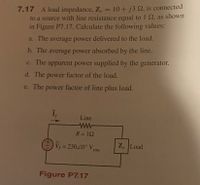
Introductory Circuit Analysis (13th Edition)
13th Edition
ISBN: 9780133923605
Author: Robert L. Boylestad
Publisher: PEARSON
expand_more
expand_more
format_list_bulleted
Concept explainers
Question

Transcribed Image Text:7.17 A load impedance, Z, = 10+ j3 2, is connected
to a source with line resistance equal to 1 2, as shown
in Figure P7.17. Calculate the following values:
a. The average power delivered to the load.
b. The average power absorbed by the line.
c. The apparent power supplied by the generator.
d. The power factor of the load.
e. The power factor of line plus load.
Line
ww-
R= 12
Vy = 23020° V,
3D23020° V
Z. Load
rms
Figure P7.17
Expert Solution
This question has been solved!
Explore an expertly crafted, step-by-step solution for a thorough understanding of key concepts.
This is a popular solution
Trending nowThis is a popular solution!
Step by stepSolved in 4 steps with 5 images

Knowledge Booster
Learn more about
Need a deep-dive on the concept behind this application? Look no further. Learn more about this topic, electrical-engineering and related others by exploring similar questions and additional content below.Similar questions
- If the line-to-line primary voltage and line current is 1.0 at 0 degrees, what is the secondary line- to-line voltage for the following three-phase transformers? Assume a turns ratio of N = 10. Express answer in polar form. a. Delta-to-Delta: b. Delta-to-Wye: c. Wye-to-Delta: d. Wye-to-Wye:arrow_forwardThe steady-state voltage drop between the load and the sending end of the line seen in (Figure 1) is excessive Suppose that V-4950/0° V (rms). A capacitor is placed in parallel with the 192 kVA load and is adjusted until the steady-state voltage at the sending end of the line has the same magnitude as the voltage at the load end, that is, 4950 V (rms). The 192 kVA load is operating at a power factor of 0.8 lag. Part A Calculate the size of the capacitor in microfarads if the circuit is operating at 60 Hz. In selecting the capacitance, use the value that results in the lowest possible power loss in the line. Express your answer in microfarads to three significant figures. ▸ View Available Hint(s) Figure 1 of 1 202 1100 192 kVA 0.8 lag ΜΕ ΑΣΦ. 11 vec C= 22.8 Submit Previous Answers Incorrect; Try Again; 5 attempts remaining Provide Feedback ? Farrow_forwardIn power distribution systems, what is sometimes necessary to install to reduce harmonic frequencies and distortion between the three-phase transformers and distribution panels?arrow_forward
Recommended textbooks for you
 Introductory Circuit Analysis (13th Edition)Electrical EngineeringISBN:9780133923605Author:Robert L. BoylestadPublisher:PEARSON
Introductory Circuit Analysis (13th Edition)Electrical EngineeringISBN:9780133923605Author:Robert L. BoylestadPublisher:PEARSON Delmar's Standard Textbook Of ElectricityElectrical EngineeringISBN:9781337900348Author:Stephen L. HermanPublisher:Cengage Learning
Delmar's Standard Textbook Of ElectricityElectrical EngineeringISBN:9781337900348Author:Stephen L. HermanPublisher:Cengage Learning Programmable Logic ControllersElectrical EngineeringISBN:9780073373843Author:Frank D. PetruzellaPublisher:McGraw-Hill Education
Programmable Logic ControllersElectrical EngineeringISBN:9780073373843Author:Frank D. PetruzellaPublisher:McGraw-Hill Education Fundamentals of Electric CircuitsElectrical EngineeringISBN:9780078028229Author:Charles K Alexander, Matthew SadikuPublisher:McGraw-Hill Education
Fundamentals of Electric CircuitsElectrical EngineeringISBN:9780078028229Author:Charles K Alexander, Matthew SadikuPublisher:McGraw-Hill Education Electric Circuits. (11th Edition)Electrical EngineeringISBN:9780134746968Author:James W. Nilsson, Susan RiedelPublisher:PEARSON
Electric Circuits. (11th Edition)Electrical EngineeringISBN:9780134746968Author:James W. Nilsson, Susan RiedelPublisher:PEARSON Engineering ElectromagneticsElectrical EngineeringISBN:9780078028151Author:Hayt, William H. (william Hart), Jr, BUCK, John A.Publisher:Mcgraw-hill Education,
Engineering ElectromagneticsElectrical EngineeringISBN:9780078028151Author:Hayt, William H. (william Hart), Jr, BUCK, John A.Publisher:Mcgraw-hill Education,

Introductory Circuit Analysis (13th Edition)
Electrical Engineering
ISBN:9780133923605
Author:Robert L. Boylestad
Publisher:PEARSON

Delmar's Standard Textbook Of Electricity
Electrical Engineering
ISBN:9781337900348
Author:Stephen L. Herman
Publisher:Cengage Learning

Programmable Logic Controllers
Electrical Engineering
ISBN:9780073373843
Author:Frank D. Petruzella
Publisher:McGraw-Hill Education

Fundamentals of Electric Circuits
Electrical Engineering
ISBN:9780078028229
Author:Charles K Alexander, Matthew Sadiku
Publisher:McGraw-Hill Education

Electric Circuits. (11th Edition)
Electrical Engineering
ISBN:9780134746968
Author:James W. Nilsson, Susan Riedel
Publisher:PEARSON

Engineering Electromagnetics
Electrical Engineering
ISBN:9780078028151
Author:Hayt, William H. (william Hart), Jr, BUCK, John A.
Publisher:Mcgraw-hill Education,